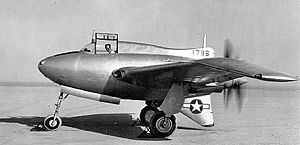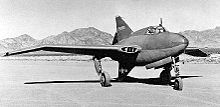- Northrop XP-56 Black Bullet
-
XP-56 Black Bullet Northrop XP-56 Black Bullet, first aircraft. Role Fighter Manufacturer Northrop First flight 1943-09-30 Status Cancelled Number built 2 The XP-56 Black Bullet was a unique prototype fighter interceptor built by Northrop. It was one of the most radical of the experimental aircraft built during World War II. Ultimately, it was unsuccessful, and never produced.
Contents
Design and development
The initial idea for the XP-56 was quite radical for 1939. It was to have no horizontal tail, only a small vertical tail, used an experimental engine, and be produced using a novel metal. The plane was to be a wing with a small central fuselage added to house the engine and pilot. The hope was that this configuration would have less aerodynamic drag than a conventional airplane.
The idea for this single-seat airplane originated in 1939 as the Northrop N2B model. It was designed around the Pratt & Whitney liquid-cooled X-1800 engine in a pusher configuration driving contra-rotating propellers. The US Army ordered Northrop to begin design work on 22 June 1940, and after reviewing the design ordered a prototype aircraft on 26 September 1940. Shortly after design work had begun, Pratt & Whitney, however, stopped development of the X-1800. The Pratt & Whitney R-2800 engine was substituted, although it was considered not entirely suitable. Although the new engine was more powerful (2,000 hp vs 1,800 hp) it had a larger diameter and required a larger fuselage to house it. This change delayed the program by five months[1]. It was expected that the new engine would require a 2,000 lb weight increase and cost 14 mph in top speed[1].
Since this tailless design was novel and considered high risk, it was decided to construct a small, lightweight plane of similar configuration for testing called the Model N1M. In parallel with the design of the XP-56, successful flight trials of the configuration were conducted this airframe, confirming the basic layout. Two small Lycoming engines powered this aircraft. These trials confirmed the stability of the radical design and, upon review, the Army decided to construct a second prototype, which was ordered on 13 February 1942[1]. Had only one prototype been constructed, its loss would have been quite a setback.
Northrop constructed the XP-56 using magnesium alloy for the airframe and skin, because aluminum was forecast to be in short supply due to wartime demands. At the time there was little experience with magnesium aircraft construction. Magnesium can not be easily welded using conventional techniques. Northrop hired Vladimir Pavlecka to develop the heliarc welding technique for magnesium alloy [1]. Later it was discovered that in the 1920s General Electric had already developed similar techniques[1].
First prototype
First engine runs in the airplane were conducted in late March, 1943, but excessive propeller shaft flex caused the engine to fail. Pratt and Whitney did not send another engine until August, causing a five month delay.
Taxi tests of the XP-56 began in 6 April 1943 and showed a serious yaw problem. At first it was thought to be caused by uneven wheel brakes, and considerable effort was placed into fixing this problem. Manual hydraulic brakes were installed and the aircraft flew on 30 September 1943 at Muroc Air Base in southern California. Eventually the yaw problem was traced to a lack of aerodynamic stability, and to fix this the upper vertical stabilizer was enlarged from a mere stub to one much larger.
After a number of flights, the first XP-56 was destroyed 8 October 1943 when the tire on the left gear blew out during a high-speed (~130 mph) taxi across Muroc Dry Lake. The pilot survived with minor injuries.
Second prototype
A number of changes were made to the second prototype, including re-ballasting to move the center-of-gravity forward, increasing the size of the upper vertical tail, and reworking the rudder control linkages. This second prototype was not completed until January 1944.[1] The aircraft flew on 23 March 1944. The pilot had difficulty lifting the nose wheel below 160 mph (257 km/h).[citation needed] He also reported extreme yaw sensitivity. This flight lasted less than eight minutes, but subsequent flights were longer, and the nose heaviness disappeared when the landing gear was retracted. Only relatively low speeds were attained, however. While urging NACA to investigate the inability to attain designed speeds, further flight tests were made. On the tenth flight the pilot noted extreme tail heaviness, lack of power, and excessive fuel consumption. Flight testing was then ceased as too hazardous, and the project was abandoned after a year of inactivity. By 1946 the Army was developing jet-powered fighters, and had no need for a new piston-powered fighter aircraft.
Survivors
- XP-56 Black Bullet, s/n 42-38353, is in storage at the Smithsonian Institution's National Air and Space Museum in Washington D.C.. On 20 December 1946 the Army shipped the second prototype to Freeman Field, Indiana, for storage. It became part of the National Air and Space Museum's collection in 1950-51 when the Smithsonian moved this collection to Suitland, Maryland.[2]
Timeline[1]
- 20 June 1940—Development contract signed.
- 4 October 1940—Original engine's development canceled.
- 5 September 1941—Second prototype ordered.
- 15 July 1941—Mockup of design inspected by Army.
- March 1943—First prototype completed. Engine runs begin.
- 6 April 1943—High speed taxi tests.
- 6 September 1943—First flight.
- 8 October 1943—Additional taxi tests after prototype modifications, first prototype crashes.
- January 1944—Second prototype completed.
- 23 March 1944—Second prototype's first flight.
- January 1946—Development stops.
Specifications (XP-56 estimates)
General characteristics
- Crew: one, pilot
- Length: 27 ft 6 in (8.38 m)
- Wingspan: 42 ft 6 in (12.96 m)
- Height: 11 ft 0 in (3.35 m)
- Wing area: 306 ft² (28.44 m²)
- Empty weight: 8,700 lb (3,955 kg)
- Loaded weight: 11,350 lb (5,159 kg)
- Max takeoff weight: 12,145 lb (5,520 kg)
- Powerplant: 1 × Pratt & Whitney R-2800-29 radial, 2,000 hp (1,492 kW)
Performance
- Maximum speed: 465 mph at 25,000 ft (749 km/h)
- Range: 660 miles (1,063 km)
- Service ceiling: 33,000 ft (10,061 m)
- Rate of climb: 3,125 ft/min at 15,000 ft (953 m/min)
- Wing loading: 37 lb/ft² (181 kg/m²)
- Power/mass: 0.18 hp/lb (0.96 kW/kg)
Armament
- 2 × 20 mm (.79 in) cannons
- 4 × .50 in (12.7 mm) machine guns
See also
- Related development
- Aircraft of comparable role, configuration and era
References
- Notes
- Bibliography
- Allen, R.S. The Northrop Story. New York: Orion, 1990. ISBN 0-517-56677-4.
- Andersen, Fred. Northrop - An Aeronautical History: a Commemorative Book Edition of Airplane Designs and Concepts. Century City, California: Northrop Corporation, 1976. Library of Congress nr. 76-22294.
- Balzer, Gerald H. American Secret Pusher Fighters of World War II: XP-54, XP-55, and XP-56. North Branch, Minnesota: Specialty Press, 2008. ISBN 1-58007-125-2.
- Green, William. War Planes of the Second World War, Volume Four: Fighters. London: MacDonald & Co. (Publishers) Ltd., 1961 (Sixth impression 1969). ISBN 0-356-01448-7.
- Green, William and Swanborough, Gordon. WW2 Aircraft Fact Files: US Army Air Force Fighters, Part 2. London: Macdonald and Jane's (Publishers) Ltd., 1978. ISBN 0-354-01072-7.
- Jenkins, Dennis and Landis, Tony. Experimental and Prototype U.S. Air Force Jet Fighters 2008, ISBN 978-1-58007-111-6.
- Maloney, Edward T. Northrop Flying Wings. Buena Park, California: Planes Of Fame Publishers, 1975. ISBN 0-915464-00-4.
- Pape, Gerry and Campbell, John M. & Donna. The Flying Wings of Jack Northrop. Atglen, Pennsylvania: Schiffer, 1994. ISBN 0-88740-597-5.
- Woolridge, E.T. Winged Wonders - The Story of the Flying Wings. Washington, D.C.: Smithsonian Press, 1983. ISBN 0-87474-966-2.
Northrop aircraft Manufacturer
designations'Greek' series'N' seriesNote: Northrop company designations include a wide variety of technologies. Only aircraft, aero engines, and missiles are linked here.
N-1 · N-2 · N-3 · N-4 · N-5 · N-6 · N-7 · N-8 · N-9 · N-10 · N-12 · N-14 · N-15 · N-16 · N-18 · N-19 · N-20 · N-21 · N-23 · N-24 · N-25 · N-26 · N-29 · N-31 · N-32 · N-34 · N-35 · N-36 · N-37 · N-38 · N-39 · N-40 · N-41 · N-46 · N-47 · N-48 · N-49 · N-50 · N-51 · N-52 · N-54 · N-55 · N-59 · N-60 · N-63 · N-65 · N-67 · N-68 · N-69 · N-71 · N-72 · N-73 · N-74 · N-77 · N-81 · N-82 · N-94 · N-96 · N-102 · N-103 · N-105 · N-110 · N-111 · N-112 · N-117 · N-124 · N-132 · N-133 · N-134 · N-135 · N-138 · N-141 · N-144 · N-149 · N-150 · N-151 · N-155 · N-156 · N-205 · N-267 · N-285 · N-300'P' seriesP530 · P600 · P610
By role AttackBombersDronesFightersReconnaissanceTrainersTransportsExperimentalNames See also: TR-3USAAS/USAAC/USAAF/USAF fighter designations 1924–1962 Pursuit (pre-1948)
Fighter (post-1948)P-1 • P-2 • P-3 • XP-4 • P-5 • P-6 • XP-7 • XP-8 • XP-9 • XP-10 • P-11 • P-12 • XP-13 • XP-14 • XP-15 • P-16 • XP-17 • XP-18 • XP-19 • YP-20 • XP-21 • XP-22 • XP-23 • YP-24 • Y1P-25 • P-26 • YP-27 • Y1P-28 • P-29 • P-30 • XP-31 • XP-32 • XP-33 • XP-34 • P-35 • P-36 • XP-37 • P-38 • P-39 • P-40 • XP-41 • XP-42 • P-43 • P-44 • XP-45 • XP-46 • P-47 • XP-48 • XP-49 • XP-50 • P-51 • XP-52 • XP-53 • XP-54 • XP-55 • XP-56 • XP-57 • XP-58 • P-59 • YP-60 • P-61/RF-61C • XP-62 • P-63 • P-64 • XP-65 • P-66 • XP-67 • XP-68 • XP-69 • P-70 • XP-71 • XP-72 • XP-73 • (P-74 not assigned) • P-75 • XP-76 • XP-77 • XP-78 • XP-79 • P-80 • XP-81 • P-82 • XP-83 • P-84 • XP-85 • P-86/F-86D • XP-87 • XP-88 • P-89 • XF-90 • XF-91 • XF-92 • YF-93 • F-94 • YF-95 • YF-96 • F-97 • XF-98 • F-99 • F-100 • F-101 • F-102 • XF-103 • F-104 • F-105 • F-106 • F-107 • XF-108 • XF-109 • F-110 • F-111/F-111B
Pursuit, Biplace Fighter, Multiplace YFM-1 • XFM-2
Lists relating to aviation General Aircraft (manufacturers) · Aircraft engines (manufacturers) · Airlines (defunct) · Airports · Civil authorities · Museums · Registration prefixes · Rotorcraft (manufacturers) · TimelineMilitary Accidents/incidents Records Categories:- Cancelled military aircraft projects of the United States
- Northrop aircraft
- Pusher aircraft
- Tailless aircraft
- United States fighter aircraft 1940–1949
- Aircraft with contra-rotating propellers
Wikimedia Foundation. 2010.


